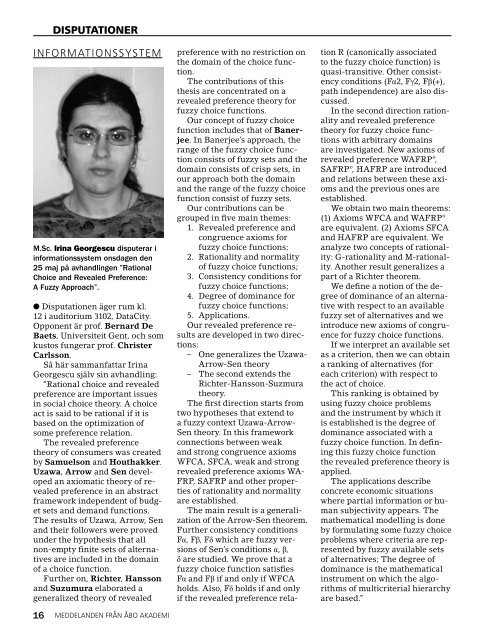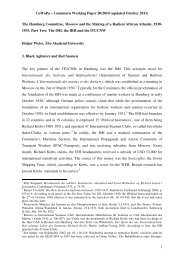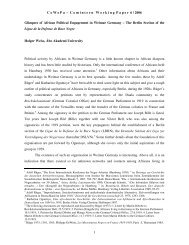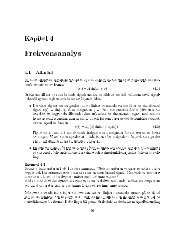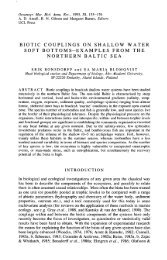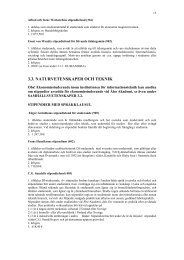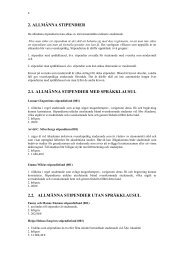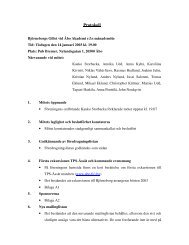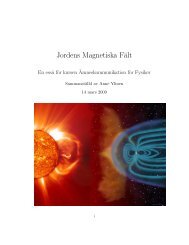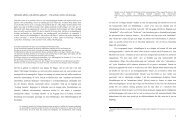Hela den tryckta tidningen som en pdf-fil (ca 1800 KB) - Åbo Akademi
Hela den tryckta tidningen som en pdf-fil (ca 1800 KB) - Åbo Akademi
Hela den tryckta tidningen som en pdf-fil (ca 1800 KB) - Åbo Akademi
Create successful ePaper yourself
Turn your PDF publications into a flip-book with our unique Google optimized e-Paper software.
DISPUTATIONER<br />
INFORMATIONSSYSTEM<br />
M.Sc. Irina Georgescu disputerar i<br />
informationssystem onsdag<strong>en</strong> <strong>d<strong>en</strong></strong><br />
25 maj på avhandling<strong>en</strong> ”Rational<br />
Choice and Revealed Prefer<strong>en</strong>ce:<br />
A Fuzzy Approach”.<br />
● Disputation<strong>en</strong> äger rum kl.<br />
12 i auditorium 3102, DataCity.<br />
Oppon<strong>en</strong>t är prof. Bernard De<br />
Baets, Universiteit G<strong>en</strong>t, och <strong>som</strong><br />
kustos fungerar prof. Christer<br />
Carlsson.<br />
Så här sammanfattar Irina<br />
Georgescu själv sin avhandling:<br />
“Rational choice and revealed<br />
prefer<strong>en</strong>ce are important issues<br />
in social choice theory. A choice<br />
act is said to be rational if it is<br />
based on the optimization of<br />
<strong>som</strong>e prefer<strong>en</strong>ce relation.<br />
The revealed prefer<strong>en</strong>ce<br />
theory of consumers was created<br />
by Samuelson and Houthakker.<br />
Uzawa, Arrow and S<strong>en</strong> developed<br />
an axiomatic theory of revealed<br />
prefer<strong>en</strong>ce in an abstract<br />
framework indep<strong>en</strong><strong>d<strong>en</strong></strong>t of budget<br />
sets and demand functions.<br />
The results of Uzawa, Arrow, S<strong>en</strong><br />
and their followers were proved<br />
under the hypothesis that all<br />
non-empty fi nite sets of alternatives<br />
are included in the domain<br />
of a choice function.<br />
Further on, Richter, Hansson<br />
and Suzumura elaborated a<br />
g<strong>en</strong>eralized theory of revealed<br />
16 MEDDELANDEN FRÅN ÅBO AKADEMI<br />
prefer<strong>en</strong>ce with no restriction on<br />
the domain of the choice function.<br />
The contributions of this<br />
thesis are conc<strong>en</strong>trated on a<br />
revealed prefer<strong>en</strong>ce theory for<br />
fuzzy choice functions.<br />
Our concept of fuzzy choice<br />
function includes that of Banerjee.<br />
In Banerjee’s approach, the<br />
range of the fuzzy choice function<br />
consists of fuzzy sets and the<br />
domain consists of crisp sets, in<br />
our approach both the domain<br />
and the range of the fuzzy choice<br />
function consist of fuzzy sets.<br />
Our contributions <strong>ca</strong>n be<br />
grouped in fi ve main themes:<br />
1. Revealed prefer<strong>en</strong>ce and<br />
congru<strong>en</strong>ce axioms for<br />
fuzzy choice functions;<br />
2. Rationality and normality<br />
of fuzzy choice functions;<br />
3. Consist<strong>en</strong>cy conditions for<br />
fuzzy choice functions;<br />
4. Degree of dominance for<br />
fuzzy choice functions;<br />
5. Appli<strong>ca</strong>tions.<br />
Our revealed prefer<strong>en</strong>ce results<br />
are developed in two directions:<br />
– One g<strong>en</strong>eralizes the Uzawa-<br />
Arrow-S<strong>en</strong> theory<br />
– The second ext<strong>en</strong>ds the<br />
Richter-Hansson-Suzmura<br />
theory.<br />
The fi rst direction starts from<br />
two hypotheses that ext<strong>en</strong>d to<br />
a fuzzy context Uzawa-Arrow-<br />
S<strong>en</strong> theory. In this framework<br />
connections betwe<strong>en</strong> weak<br />
and strong congru<strong>en</strong>ce axioms<br />
WFCA, SFCA, weak and strong<br />
revealed prefer<strong>en</strong>ce axioms WA-<br />
FRP, SAFRP and other properties<br />
of rationality and normality<br />
are established.<br />
The main result is a g<strong>en</strong>eralization<br />
of the Arrow-S<strong>en</strong> theorem.<br />
Further consist<strong>en</strong>cy conditions<br />
Fα, Fβ, Fδ which are fuzzy versions<br />
of S<strong>en</strong>’s conditions α, β,<br />
δ are studied. We prove that a<br />
fuzzy choice function satisfi es<br />
Fα and Fβ if and only if WFCA<br />
holds. Also, Fδ holds if and only<br />
if the revealed prefer<strong>en</strong>ce rela-<br />
tion R (<strong>ca</strong>noni<strong>ca</strong>lly associated<br />
to the fuzzy choice function) is<br />
quasi-transitive. Other consist<strong>en</strong>cy<br />
conditions (Fα2, Fγ2, Fβ(+),<br />
path indep<strong>en</strong><strong>d<strong>en</strong></strong>ce) are also discussed.<br />
In the second direction rationality<br />
and revealed prefer<strong>en</strong>ce<br />
theory for fuzzy choice functions<br />
with arbitrary domains<br />
are investigated. New axioms of<br />
revealed prefer<strong>en</strong>ce WAFRPº,<br />
SAFRPº, HAFRP are introduced<br />
and relations betwe<strong>en</strong> these axioms<br />
and the previous ones are<br />
established.<br />
We obtain two main theorems:<br />
(1) Axioms WFCA and WAFRPº<br />
are equival<strong>en</strong>t. (2) Axioms SFCA<br />
and HAFRP are equival<strong>en</strong>t. We<br />
analyze two concepts of rationality:<br />
G-rationality and M-rationality.<br />
Another result g<strong>en</strong>eralizes a<br />
part of a Richter theorem.<br />
We defi ne a notion of the degree<br />
of dominance of an alternative<br />
with respect to an available<br />
fuzzy set of alternatives and we<br />
introduce new axioms of congru<strong>en</strong>ce<br />
for fuzzy choice functions.<br />
If we interpret an available set<br />
as a criterion, th<strong>en</strong> we <strong>ca</strong>n obtain<br />
a ranking of alternatives (for<br />
each criterion) with respect to<br />
the act of choice.<br />
This ranking is obtained by<br />
using fuzzy choice problems<br />
and the instrum<strong>en</strong>t by which it<br />
is established is the degree of<br />
dominance associated with a<br />
fuzzy choice function. In defi ning<br />
this fuzzy choice function<br />
the revealed prefer<strong>en</strong>ce theory is<br />
applied.<br />
The appli<strong>ca</strong>tions describe<br />
concrete economic situations<br />
where partial information or human<br />
subjectivity appears. The<br />
mathemati<strong>ca</strong>l modelling is done<br />
by formulating <strong>som</strong>e fuzzy choice<br />
problems where criteria are repres<strong>en</strong>ted<br />
by fuzzy available sets<br />
of alternatives; The degree of<br />
dominance is the mathemati<strong>ca</strong>l<br />
instrum<strong>en</strong>t on which the algorithms<br />
of multicriterial hierarchy<br />
are based.”


